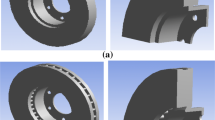Abstract
This paper presents an analysis method to estimate the thermal performance of a disc in a vehicle considering braking conditions and the characteristics of hydraulic devices such as the booster, master cylinder and proportional valve. The whole braking pressure transfer process in the hydraulic brake system from its generating by the pedal to action on the pad is analytically determined. The heat flux generated in the disc brake module is calculated by assuming that the braking energy changes into thermal energy. Heat flux is applied to the finite element disc model, and the temperature rise and deformation of a disc are estimated by performing the thermo-mechanical analysis. The analysis results are discussed and the analytical process and simulation model are verified.
Similar content being viewed by others
References
F. Talati and S. Jalalifar, Analysis of heat conduction in a disc brake system, Heat Mass Transfer, 45 (2009) 1047–1059.
J. T. Kim and B. J. Baek, A numerical study of thermal performace in ventilated disk brake, Journal of the Korean Society of Tribologists & Lubrication Engineers, 17(5) (2001) 358–364.
Y. Choi, J. W. Choi, H. M. Kim and Y. W. Seo, Thermal dissipation performance of the ventilated brake disc having helical grooved vent, Journal of the Korean Society of Precision Engineering, 21(3) (2004) 117–123.
S. M. Kim, A study on thermal analysis in ventilated brake by FEM, Journal of the Korean Society of Machine Tool Engineers, 18(5) (2009) 544–549.
P. Hwang, H. C. Seo and W. Xuan, A study on temperature field and contact pressure in ventilated disc-pad brake by 3D thermo-mechanical coupling model, Journal of the Korean Society of Tribologists & Lubrication Engineers, 25(6) 421–426.
S. P. Jung, K. J. Jun, T. W. Park and J. H. Yoon, Development of the brake system design program for a vehicle, International Journal of Automotive Technology, 9(1) (2008) 45–51.
K. J. Jun, T. W. Park, S. P. Jung, S. H. Lee and J. W. Yoon, Development of a numerical method to predict the alpine test result, Proceedings of the Institute of Mechanical Engineers, Part. D, 222 (2008) 1841–1849.
Samcef User’s Manual, Ver.13.1, 2010.
Author information
Authors and Affiliations
Additional information
This paper was recommended for publication in revised form by Associate Editor Yeon June Kang
Won Sun Chung works for Korea Automotive Technonoly Institute as a senior resercher. He is now focusing on the judder vibration of a passenger vehicle, and the hot judder phenomenon of the disc brake is one of his major interests. Also, he studies computational engineering and optimization.
Tae Won Park received a B.S. in Mechanical Engineering from Seoul National University. He then went on to receive his M.S. and Ph.D. degrees from the University of Iowa. Dr. Park is currently a Professor at the School of Mechanical Engineering at Ajou University in Suwon, Korea.
Rights and permissions
About this article
Cite this article
Chung, W.S., Jung, S.P. & Park, T.W. Numerical analysis method to estimate thermal deformation of a ventilated disc for automotives. J Mech Sci Technol 24, 2189–2195 (2010). https://doi.org/10.1007/s12206-010-0905-3
Received:
Revised:
Accepted:
Published:
Issue Date:
DOI: https://doi.org/10.1007/s12206-010-0905-3




